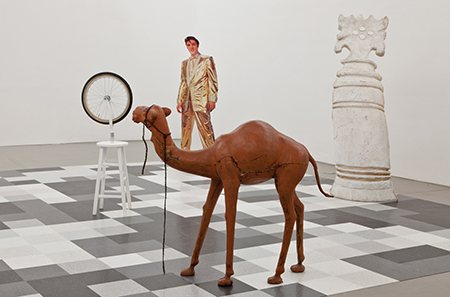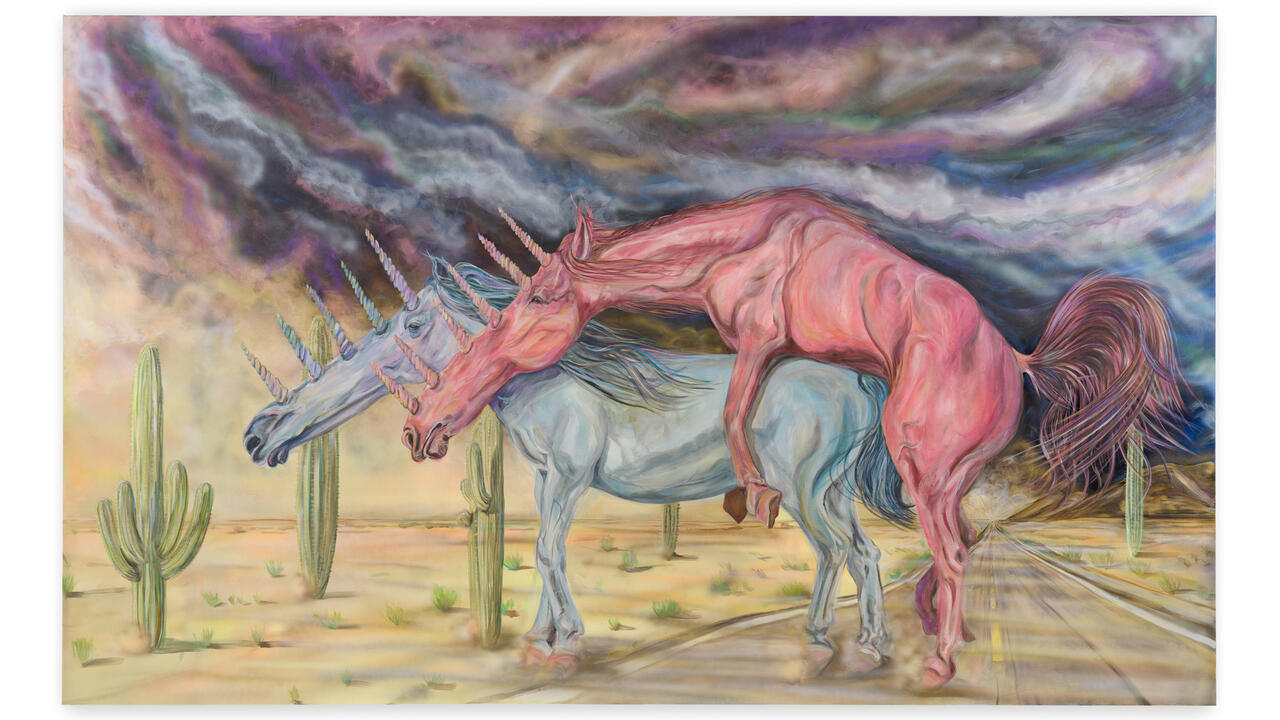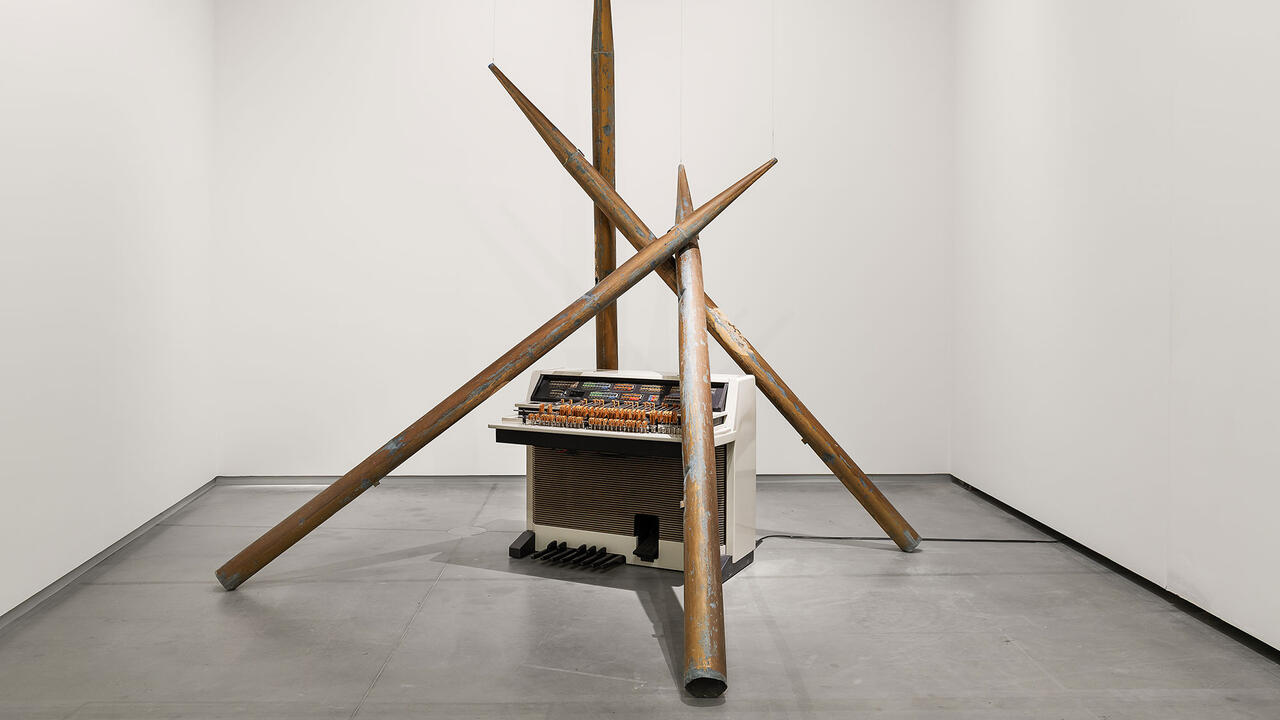Peculiar Galaxies
Looking at recent work of the legendary and elusive California-based artist Lutz Bacher
Looking at recent work of the legendary and elusive California-based artist Lutz Bacher

I found a sweet spot in Lutz Bacher’s solo exhibition this year at Portikus in Frankfurt, where quite a few things came together, though to say that they cohered would be misleading. This spot is unlikely to have been noticed, much less savoured, by the crowds that thronged to the previous night’s opening festivities, which coincided with the February Rundgang of student shows at the nearby Städelschule. Neither would its location be likely to please the architect of this eccentric but purpose-built gallery, which rises up improbably from a small island in the Main river and is accessible only by a short gangway linking its first-floor entrance to Frankfurt’s oldest bridge, the Alte Brücke.
Having navigated my way through the exhibition for the third time in 24 hours, I was on my way back down the gallery’s narrow open staircase, which scarcely allows for two people to squeeze past each other, when I found myself lingering in a particularly liminal location, my head poking over the parapet of the upper gallery, trying not to feel too self-conscious about this incongruous position. Though it was a far from ideal vantage point from which to view any one of the exhibition’s four key components individually, it was here that the whole ensemble clicked into place with the kind of magnificent perverseness typical of Bacher’s eclectic output over the past 40 years.

A legendary if elusive figure in Californian art, Bacher has for much of this time cultivated an indeterminate identity, made emblematic by her deceptively masculine pseudonym. Forged from the scavenged shards and unlovely detritus of common culture, augmented by task-orientated, generally unedited recordings that embrace chance and contingency as well as technical glitches and distortions, and infused with a caustic wit, her work has that rare capacity to be at once resolutely esoteric and brimming with anarchic energies which it can barely contain. We might take as exemplary The Celestial Handbook (2011), a sequence of 85 purloined pages depicting various night-sky phenomena, including one particular photo whose accompanying text describes its subject as follows: ‘One of the most peculiar galaxies known, this strange system seems to be ejecting matter with explosive violence.’ A more succinct account of the world of Lutz Bacher I have yet to read.
The most substantial, if typically oblique, of publications to date on Bacher’s multifarious oeuvre is a hefty artist’s book published in 2012 by Primary Information, whose title, Do You Love Me?, has been recycled several times, as befits her work’s presiding aesthetic. (It says something of the work’s tone that this phrase summons songs by both The Contours and Nick Cave & The Bad Seeds to my inner turntable, though the latter prevails.) The question first served as the title of a work Bacher premiered in Los Angeles in 1994 and showed a year later at the New York gallery of her long-term dealer, the late Pat Hearn, whom the artist subsequently immortalized in an extraordinary digitally animated portrait, Closed Circuit (1997–2000), comprising video stills culled from surveillance-camera footage shot in the gallerist’s private office over the course of a year.
The 1994 work ‘Do you Love Me?’ comprises a series of video interviews in which Bacher quizzes friends, curators and fellow practitioners about what they think of her as a person and as an artist, in a manner best described as warmly combative. However, ‘Do You Love Me?’ also designates a more recent series of interviews from 2008–09, which have since been extended into a book and interspersed with degraded, black and white images gleaned from Bacher’s back catalogue. The question also did duty as the title of a tour de force installation at the Kunstverein Munich in 2009. This latter was the third in a trilogy of major presentations of the artist’s work that year, which sparked a dramatic rise in her visibility on both sides of the Atlantic – a wave that continues to gather momentum. (The other two venues were the Contemporary Art Museum St. Louis and MoMA PS1 in New York.) This year, the Portikus show was likewise part of a trilogy of interrelated exhibitions unfolding across Europe, the second of which opened at the ICA in London in September, before travelling to the Kunsthalle Zürich in November.
The most spectacular element at Portikus was given pride of place in its main gallery. Chess (2012) was an irregularly patterned grey-scale grid of mottled tiles, allowing enough room for viewers to skirt it, on which five oversized objets trouvés were arranged around a replica of an art-historical icon, like so many pieces in an arcane board game. (Viewed from the balcony, this grid also suggested a crudely pixelated image, or an old-fashioned test card on the screen of a black and white TV set.) Two of these objects were giant chess pieces – a queen and a bishop, or the freestanding, off-white half-shells thereof – and two were cardboard cut-outs of the kind once common in movie-theatre foyers, the first depicting a rampant Tyrannosaurus rex and the second a young Elvis Presley, resplendent in his gold lamé suit. Two kings, in effect, one feared, one loved, though neither black nor white. In contrast to these more-or-less two-dimensional figures, the fifth piece was a fully rounded, if dilapidated, camel, which could be construed in this context as the exotic, downbeat equivalent of a knight.

Like the rest of this ragtag platoon, the camel appeared to be arrested in a warily circular movement around the sixth and final piece, a not-quite-right knock-off of Marcel Duchamp’s Bicycle Wheel (1913), sourced from a surplus store, as were all the other pieces. Its focal position suggested power, if not dominion. It also spoke of precedence, given that art history regards the ‘original’ Bicycle Wheel as the earliest example of that category so crucial to Bacher’s work, the readymade, though it was not designated as such by its maker until some years after its genesis. That the camel most probably began life as an attendant figure at a Christmas manger also, however, allowed for a reading of this scenario as a bizarre Nativity play, with Duchamp cast by proxy in the dual role of mage (i.e. a third king) and infant messiah. Accompanying this arresting, polysemous tableau was Elvis (2009), a looped sound work in which the mellifluous voice of The King wordlessly explored its more ‘feminine’ upper reaches.
Meanwhile, upstairs, things were looser and darker, especially on opening night when the natural light that streams through a low row of narrow rectangular windows by day was absent, and the space was illuminated only by a single fluorescent strip on a low-slung rafter. Though the spirit of Duchamp remained, in this case it was more the Duchamp of the all-encompassing, so-called mile of string (his twine, 1942) than the inveterate chess-player. Here the entire gallery floor was covered with a thick, undulating layer of glistening black coal slag. (Bacher has used this ploy on several occasions, but with sand; just as other life-sized cut-outs, mannequins and dolls from her evidently extensive hoard have found their way into various installations over the years.) Embedded in this nocturnal, indoor beach were half-a-dozen old-fashioned Sony Cube monitors showing video footage of a ‘blue moon’ filmed by Bacher from a stationary camera through the window of her house in Berkeley, California.

Blue Moon (1996) ironically literalizes the precise meaning of a phrase more often deployed metaphorically – that is, a second full moon appearing in the same calendar month – in that the refraction of the moon’s image through the window pane and/or camera lens produced a second moon, which was smaller but clearer, on account of the optics involved. As time slips by, the two moons travel erratically across the frame and eventually pass beyond it. While the dominant element in the video’s ambient soundtrack is an Irish gangster movie, it also registers other background noises such as footsteps on floorboards, snatches of conversation, the clinking of bottles, the sounds of street traffic, and some intermittent tv channel-surfing across various music and news stations. It was while straining to identify these disparate sounds, so redolent of late-night urban life, but relayed at several removes through time and space, that I became gradually aware once again of the transporting swell of the Ennio Morricone-like soundtrack from the gallery below, still clearly audible from my perch on the upper staircase.
Glancing back down, a third component of the exhibition loomed from a ledge at the foot of the stairs on which it was propped. The Baby (2012), a blown-up snapshot of an infant reaching out in wonder to touch its own image in a looking-glass, was gleaned, it seems, from a batch of abandoned family photographs Bacher found lying in the street back in the 1980s. It also provided, I finally realized, the perfect foil to the show’s fourth and final component. Visible only from outside the building, this gigantic, rudimentary drawing was actually the first image encountered by most visitors. Outlined in white against the expanse of blacked-out glass and slate that constitutes the north face of Portikus’s steeply pitched roof, this figure could be clearly seen from a distance, both by day and by night. At once a signature icon of Bacher’s and an illustration familiar from a dozen textbooks, the ‘duck-rabbit’ (or, as Bacher prefers, the Duck Bunny) is a classic figure best known from Ludwig Wittgenstein’s ruminations on ambiguity in the Philosophical Investigations (1953), and his crucial distinction between ‘seeing that …’ and ‘seeing as …’. It also incidentally reflected my own paradoxical perspective on the exhibition in a position from which it was impossible to perceive more than one element at a time, but much easier to comprehend its totality.

The relationship between an ideal, imaginary whole and an unruly, fragmentary real was also subtly underscored by The Baby, which might easily have been mistaken for a deliberately staged illustration of Jacques Lacan’s early account of subject formation. Few people familiar with Bacher’s occasionally baffling work would describe it as schematic, and the danger of reductiveness inherent to the exegetic endeavour should not be discounted. That said, the Portikus show provided an unusually limpid example of Bacher’s penchant for dualistic thinking, in spite of the equally characteristic eccentricity and recalcitrance of its constituent parts. The twinned moons, paired kings and mirrored babies – when viewed within the matrix of the show’s myriad oppositions between night and day, above and below, 2D image and 3D object, the found and the fabricated, movement and stasis, masculine and feminine, aggregate field and ordered grid, ethereal sounds and base materials – suggested something akin to what Claude Lévi-Strauss, to invoke a final ‘forefather’ of 20th-century art and philosophy, understood as mythical thinking back in the salad days of structuralist anthropology.
Yet if, as Lévi-Strauss proposed, ‘mythical thought always works from an awareness of oppositions towards their progressive mediation’, the innate orneriness of Bacher’s work alone should be sufficient to ensure that in her case such mediations, in keeping with a more post-structuralist ethos of indeterminacy, are likely to be indefinitely deferred. The artist herself has noted that one of the contrary impulses which continues to propel her work is that ‘weird conjunction of the conceptual and the visceral that we all juggle’. While a recurring trope in her recent installations is that of a vast scattering of small balls rolled to a halt on a gallery floor, including a sea of well-worn baseballs that graced the fourth floor of the Whitney Museum of American Art during last year’s Biennial, such are Bacher’s skills of prestidigitation that this four-decade-long feat of juggling shows little sign of faltering.
Lutz Bacher lives and works in New York, USA. Recent solo exhibitions include Contemporary Art Museum St. Louis (2008–09), Kunstverein Munich (2009) and MoMA PS1, New York (2009). In 2013, she is presenting three solo exhibitions: Portikus, Frankfurt, Germany; ICA, London, UK; and Kunsthalle Zurich, Switzerland. A catalogue accompanying all three shows will be published by JRP | Ringier.
Page from The Celestial Handbook, 2011, offset book pages, 85 parts, each 23 × 15 cm. Courtesy: the artist, Galerie Buchholz, Berlin/Cologne, Greene Naftali, New York, and Portikus, Frankfurt; photograph: Helena Schlichting






















